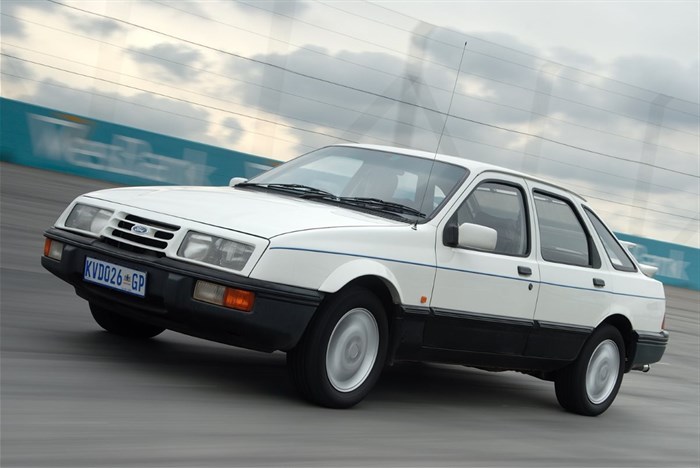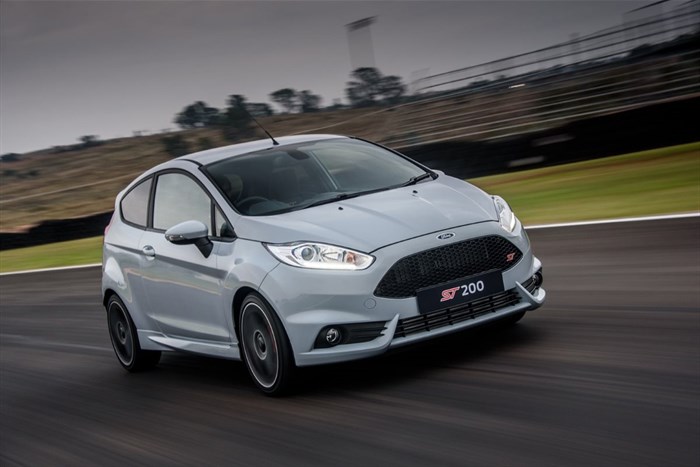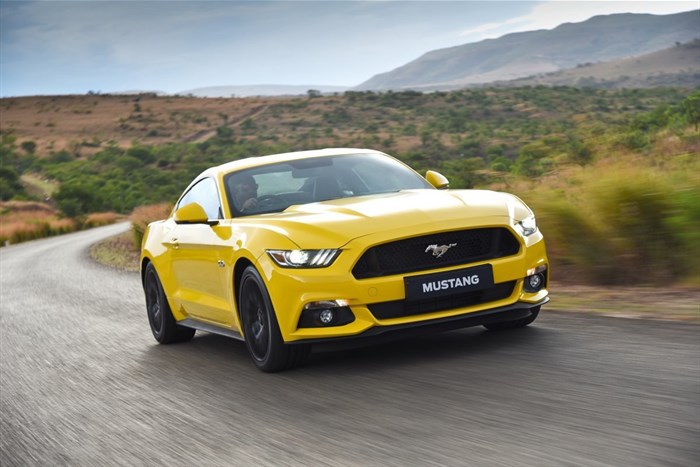Ford South Africa has developed and launched several iconic cars for local enthusiasts over the decades. Many of these developments have been unique to the South African market, building the Ford brand and heritage on our local roads and racetracks.

Ford Capri Perana | Source: Supplied
Ford has a rich history in South Africa, and a legacy of always being in tune with local appetites and trends. So much so that Ford has commissioned and developed many vehicles unique to South Africa, many of these to defend Ford’s True Blue legendary status on local racetracks, and others to fill gaps uniquely found on the local motoring landscape.
Ford Capri Perana – 1970
The late Basil Green is synonymous with not only the Ford Capri Perana, but also many other Fords from the 1960s and ’70s found on our roads and racetracks. The Perana was a locally developed vehicle that aligned with Ford’s global commitment to its “Total Performance” advertising campaign from the period, and the road cars were officially available through Ford dealerships across the country. The Capri Perana was particularly renowned for its dominance in South Africa’s Group 5 racing, especially during the 1970 season. That year, Bobby Olthoff, with his Capri Perana V8 Gunston-livery car number Z181, won 13 out of the 14 races.
The Capri Perana is unique in that it is the only Ford factory-sancti. Both four-speed manual and three-speed automatic transmissions were available to buyers, although today collectors tend to prefer the manual version over the automatic.
The Capri Perana was identified by its larger wheels and double exhaust pipes, to name but two upgrades. In a car tipping the scales at just below 1,100 kg, with 210kW and 407Nm on tap, the performance was truly overwhelming at the time. The two official exterior body colours were Bright Yellow and Piri Piri Red. Likely because of its on-track success, it turned out to be a hit with the public as well, with Basil Green Motors shifting around 500 road cars. The company also produced Perana versions of the Escort, Cortina and Granada in the Sixties and early Seventies.
Ford Cortina Mk3 bakkie – 1971
Enthusiasts will remember that a few years after the Cortina bakkie was unveiled, Ford released a limited-edition Cortina bakkie and sedan known as the Springbok edition. These vehicles, painted green and gold, left no doubt about their purpose: showing support for the Springbok team during the 1976 All Blacks tour of South Africa.
Both the sedan and the bakkie featured a gold-painted roof and wheels with a pinstripe running along the side of the vehicles. The rest of the car was painted green. The success of the original Cortina bakkie has also proven to be the genesis of the word bakkie in motoring, which is still used by all South Africans to refer to any type of light utility pick-up. The Cortina bakkie idea was then carried over to the Mk4 and 5 versions of the Cortina and it proved to be an exceptionally tough vehicle, with some of them still seen to this day plying their trade.
Ford Cortina XR6 Interceptor – 1981
A performance version of the MK4 Cortina, named the 3.0S, was developed by Ford’s Motorsport division in the late 1970s. It was fitted with the 3l “Essex” V6 and had uprated and slightly lowered suspension, among other improvements. This car evolved into the better-known Mk5 Cortina XR6. An iconic Ford print ad at the time for the XR6 said: “Buckle in for the drive of your life.”

Ford Cortina XR6 Interceptor | Source: Supplied
Celebrating its motorsport successes, the company produced a Team Ford, or “TF”, edition of the Cortina XR6 with distinctive blue pin striping, however, the ultimate development of the Cortina range came in the form of the legendary XR6 Interceptor, another homologation special to allow Ford to go racing.
Painted Wild Coral Red, this model stood out from all other Cortina models, replete with its shading slats over the rear window, the small black boot spoiler and the double, four-spoke wheels. If other drivers saw the car approaching in their rear-view mirrors, there was no mistaking it for anything else on the road. Each car’s number was also individually printed at the bottom of the C-pillar and corresponded with the chassis plate.
As with all homologation specials, one of the stand-out features was the engine. The Interceptor’s 3l V6 featured a set of triple downdraft 42 Weber carburettors and new high-performance exhaust manifolds. One of the internal upgrades to the engine was a more aggressive camshaft. The result was 118kW, a healthy increase over the standard 101kW Essex V6 engines. To aid handling, wider Ronal 13-inch wheels were fitted to these cars. Further suspension upgrades rounded out the package.
Ford Sierra XR8 – 1984
The Sierra XR8 was another distinctive South African model, widely regarded as a true South African muscle car. The aim of the XR8 was to develop a production car that Ford could take to the racetrack, taking on other competitors for the Group One crown. For that to happen, at least 200 cars needed to be sold, and the race car had to be based on a production car, making it a true homologation special.
The 5l V8 engine came from none other than Ford’s halo performance car at the time, the Ford Mustang. The engine was bolted to a Borg Warner five-speed manual gearbox and a Borg Warner differential. It developed 161kW and 374Nm, breathing through a four-barrel Holley Carburettor. The side shafts as well as the drive shaft were upgraded to deal with the additional power. Ford also upgraded the suspension and braking system to harness the additional power and torque.

Ford Sierra XR8 | Source: Supplied
The purposeful Ronal alloy wheels, specially designed and manufactured for the XR8, came from Germany. All XR8s were painted white with Ford Motorsport-inspired blue stripes, while the lower panels were finished in grey-blue moulded PVC.
One of the most notable design elements of the road car was the double-plane rear wing – an element that was not only visible from a distance, but left the driver and fellow road users in no doubt as to the intent of the most-powerful production Sierra in South Africa. Including prototypes, just more than 250 were manufactured. Another external cue unique to the XR8 was a slatted grille, providing more airflow to cool the big V8. Nowhere else was the Sierra officially sold with a V8 engine, making these cars highly sought after by Ford enthusiasts all over the world.
During its final years, the Sierra XR8 was raced by Willie Hepburn in the WesBank Modified series. The car quickly earned the nickname “The Animal” and went on to secure an unforgettable win at the old Kyalami circuit in 1987. Official performance testing at the time revealed an impressive 0 to 100 km/h time of only 6.95 seconds, and a top speed of 231 km/h, making the Sierra XR8 South Africa’s fastest standard four-door production car at the time.
Modern classics
Vehicles from the 1990s and 2000s are now often referred to as modern classics, with their values steadily rising. In this era, Ford re-introduced cherished performance cars to the South African market, which encompassed various hot hatches and the highly anticipated Ford Mustang.
Ford ST and RS family
To cover the more affordable end of the performance market, Ford introduced the first Focus ST in 2003. It was based on the first-generation Focus and named the ST170, after the number of horsepower the engine developed.
The first Fiesta ST, the ST150, was introduced a few years later. Both these models were instantly loved by South Africa’s motoring enthusiasts. The three-door, front-wheel drive ST170 was fitted with a 2l four-cylinder engine developing 126kW and 195Nm. The more compact and lighter Fiesta ST’s naturally aspirated 2.0-litre engine produced 112kW and 190Nm.
Both these cars were renowned for their handling capabilities, with many an enthusiast still to this day waxing lyrical about their crisp turn-in. The next-generation Focus ST was offered with the iconic 2.5l five-cylinder turbo petrol engine developing 166kW and 320Nm. This ST was offered in both a three-door and five-door style to tempt South African buyers.

Ford ST200 2017 | Source: Supplied
Ford further developed the 2.5l turbocharged engine and the result was the Focus RS. It offered 184kW and 340Nm and was sold in limited numbers in South Africa. The RS featured Ford’s RevoKnuckle suspension setup as well as a Quaife limited slip differential.
Subsequently, Ford transitioned to four-cylinder turbo engines for the final local performance iterations of the Focus. The five-door ST’s 2l developed 184kW and 360Nm, decisively powering this hot hatch. Turbocharging was used in the performance version of the Fiesta for the first time too, with the 1.6-litre engine developing 134kW and 240Nm.
Locally, Ford’s swansong for the ST and RS models came in the shape of the all-wheel drive Focus RS with its 2.3l EcoBoost engine delivering 257kW and 440Nm. This meant the RS was now firmly in the super – or hyper–hatch territory. The Fiesta ST200 saw the introduction of a more powerful version of the base ST, with outputs increased to 147kW and 240Nm. This little pocket-rocket is known for its playful and dynamic nature, and has become a true icon in the high-performance Fiesta range.
Arrival of the fabled Ford Mustang
Ford has launched iconic performance models throughout the decades, but the cherry on top arguably arrived in 2015 with the introduction of the long-awaited and legendary Ford Mustang. This was the first generation of the Mustang to be produced in right-hand drive, thus making it accessible to South African buyers.
Since its introduction, it has been one of the best-selling performance cars in South Africa. Introduced with both the 5l V8 as well as the 2.3l four-cylinder EcoBoost engine, customers could balance performance and price to suit their needs. Buyers could also choose between Fastback or Convertible and automatic or manual versions. Soon, higher-performance versions of both the coupé and the cabriolet were made available to the public, including the special edition Mustangs: Bullitt, Mach 1 and California Special. This neatly complemented the official Shelby versions, built locally by Shelby South Africa, as well as Roush alternatives, in mild to wild flavours and temperaments.

Ford Mustang | Source: Supplied
From the early days when legends like Basil Green adeptly tuned classic Fords to the present, where Ford’s high-performance Mustangs and the mighty twin-turbo 292kW Ranger Raptor rule the roost, the company has consistently delivered iconic models to South African enthusiasts throughout the decades. With deep roots in the South African market and racing circuits, Ford is poised to continue crafting and introducing more iconic models long into the future.










































